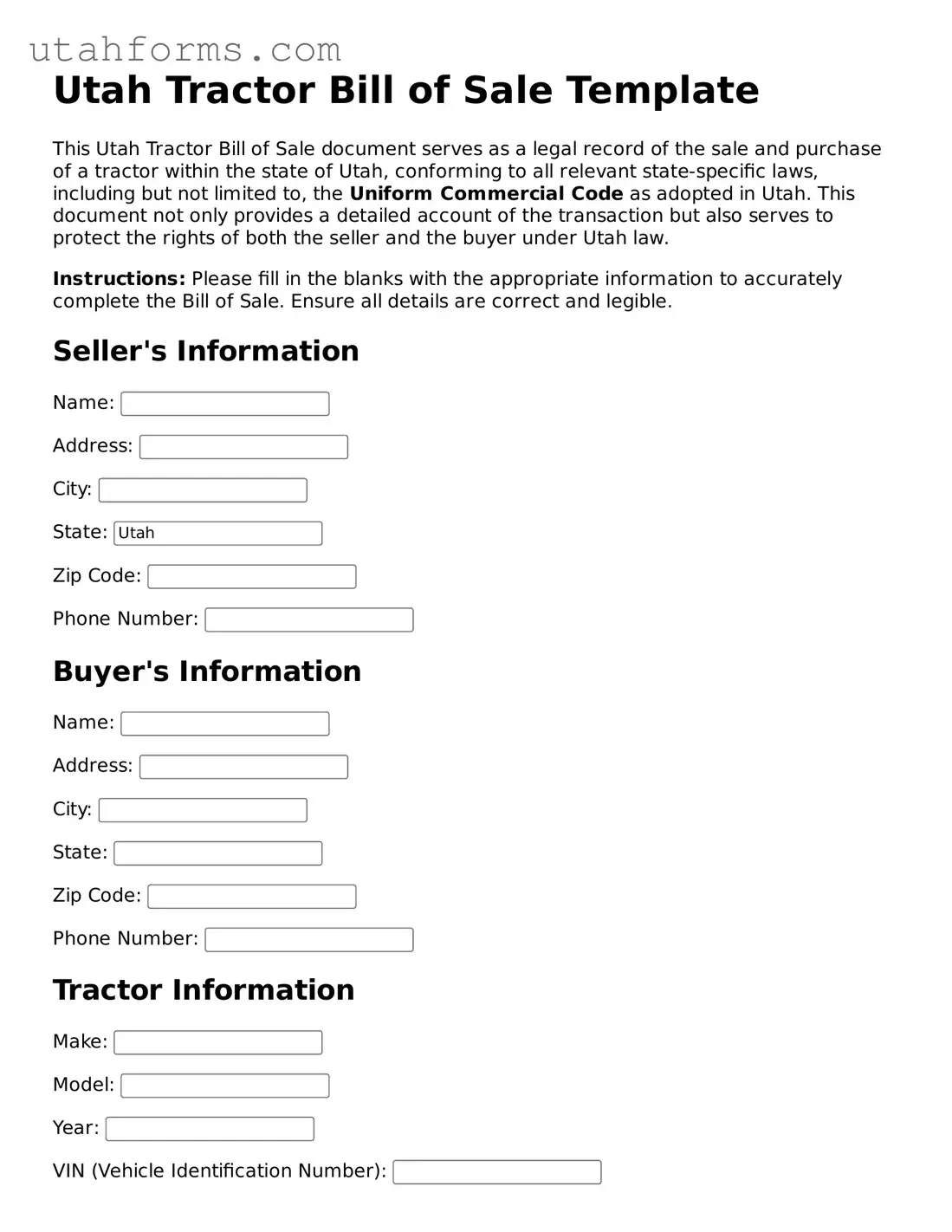The Utah Tractor Bill of Sale form shares similarities with a Vehicle Bill of Sale, often used when buying or selling a car, truck, or motorcycle. Both documents serve as legal proof of a transaction, detailing the transfer of ownership from the seller to the buyer. They typically include the sale date, purchase price, and specifics about the item sold, such as make, model, and identification number. These forms are crucial for registration, tax, and legal purposes, ensuring that all parties have a record of the sale.
Similar to a Boat Bill of Sale, the Utah Tractor Bill of Sale form documents the sale of a specific item — in this case, a tractor, whereas for the boat form, a watercraft. Each form includes pertinent details like the vessel's or tractor's description, the sale amount, and the parties' information. Both documents are essential for recording the transfer of ownership and can be necessary for registration with the respective state authorities, protecting both buyer and seller interests.
A Firearms Bill of Sale closely mirrors the structure and function of the Utah Tractor Bill of Sale form. This document is used in the transfer of ownership of a firearm from one party to another. It provides a detailed record of the transaction, including personal details of the buyer and seller, firearm specifics, and the sale price. Similar to the tractor bill of sale, a firearms bill of sale helps ensure legal compliance and serves as proof of ownership and transaction validity.
Another similar document is the Equipment Bill of Sale, which is used for the sale and purchase of machinery and equipment other than tractors. Like the tractor bill of sale, it outlines the transaction details, including the equipment description, parties' information, and sale conditions. This form is vital for business transactions, providing a legal record of the ownership transfer of valuable equipment assets.
The Pet Bill of Sale is an agreement documenting the sale of animals, including pets. While considerably different in what it sells, this form functions similarly to the tractor bill of sale by detailing the exchange between seller and buyer, including the animal's description and the sale's terms and conditions. Both forms formalize the agreement in writing, providing legal evidence of the transaction.
The Aircraft Bill of Sale resembles the tractor bill of sale in that it documents the sale of a high-value asset — in this case, an aircraft versus a tractor. Both forms include comprehensive details about the asset sold, identification numbers, sale price, and the parties involved. They are crucial for registration purposes with the appropriate government agencies, serving as legal proof of the ownership transfer.
The Business Bill of Sale is used when an entire business, or a portion of its assets, is being sold, akin to the singular focus of a tractor in the tractor bill of sale. Both documents record the details of the transaction, including descriptions of what's being sold (whether a business or a tractor), the agreed-upon price, and the identities of the transaction parties. This facilitates a smoother transition of ownership and helps in legal and tax documentation.
Real Estate Sale Contracts, while covering the sale of real property rather than movable assets like tractors, share the purpose of formally documenting the details of a transaction. Both this contract and the tractor bill of sale include specific information about the item being sold, the agreed price, and party information, ensuring that the transfer of ownership is legally recorded.
The General Bill of Sale is a broad document that can be used for various items, including tractors, vehicles, equipment, and more, making it inherently similar to the tractor bill of sale. It serves as a catch-all document to prove the sale and transfer of ownership of personal property. The general form includes transaction details such as the description of the sold item, sale price, and participant identities, providing a legal safeguard for both buyer and seller.
Finally, the Livestock Bill of Sale parallels the tractor bill of sale when it comes to the sale of farm-related assets, except it focuses on animals rather than equipment. It contains specifics about the livestock sold, the parties involved, and the sale conditions. Both forms are pivotal for farmers and ranchers, ensuring that the sale is legally documented and the transfer of ownership is clearly established for registration, tax, and personal record-keeping purposes.
